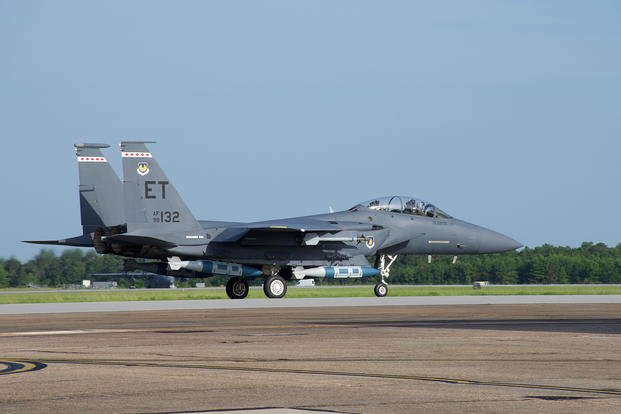As the military shifts its attention to competing against the world's major navies, the Air Force is working on a new weapon: a ship-killing GPS-guided bomb.
On Aug. 26, the Air Force Research Laboratory tested the ability to use modified 2,000-pound GBU-31 Joint Direct Attack Munitions, or JDAMs, on both stationary and moving targets on the water.
Three F-15E Strike Eagle fighters from the Eglin Air Force Base, Florida-based 85th Test and Evaluation Squadron, armed with dummy versions of the weapon, tried out a slew of different ways of using it, looking to prove it would work.
Read Next: Report Slams Police for Not Finding Dead Vet on VA Campus
In a Friday interview, Col. Anthony Meeks, director of the Air Force Research Laboratory's munitions directorate, said the test was designed to see whether pilots could drop the bombs on "different aim points to defeat maritime threats."
Those "aim points" -- the place where the crew wants the weapon to hit -- could be at the top of the vessel, the waterline, or just below the surface of the water, Meeks said.
He declined to answer whether that meant the weapon could target specific portions of a ship such as its bridge, propulsion, fuel tanks or weapons, saying the exact capabilities of the weapon are classified.
The development of the weapon comes at a time when the military is largely moving away from the last two decades of fighting land-based militant groups in the Middle East, and toward preparing for potential conflicts against major powers. Some of those adversaries, such as China, have considerable naval forces.
The Air Force's Sept. 1 press release on the test said it was intended to be "a low-cost method of achieving torpedo-like seaworthy kills from the air." However, the JDAM is not self-powered, and its velocity comes from the speed of the aircraft releasing it and gravity, while fins steer it toward its target. That means a maritime variant wouldn't streak under the surface of the water toward its target like a torpedo.
But among the modifications that have been made to this bomb are a redesigned nose plug, Meeks said. If the JDAM hits the water shortly before striking its target, that modified nose plug is intended to keep it from caroming off the surface in another unexpected direction.
"Did you ever skip rocks across the surface of a pond as a child?" Meeks asked. "What we're trying to understand is the physics, the dynamics, to prevent a JDAM from skipping off the surface of the water. We're trying to understand how a JDAM delivered to a GPS point over the water is any different, if at all, from a traditional, more conventional use of a JDAM."
Maj. Kevin Fogler, who flew the lead F-15E during the test, said in the interview that the laser-guided GBU-24 -- an older version of the weapon that is commonly used to strike hardened targets such as bunkers -- wouldn't work well during a battle with a ship.
"When the targets we're striking can shoot back, we don't necessarily want to be at the ranges we'd have to be to illuminate the target with the laser," Fogler said.
But when the GPS-guided GBU-31 is used, fighters can get out of the area immediately after firing it, and not have to loiter to keep a laser fixed on the target as they would with the GBU-24.
Laser-guided weapons also need a largely cloud-free environment to work correctly, but the GBU-31's GPS guidance would be able to work in any type of weather. Fogler said that GPS jamming capabilities are a concern, but that aircrews would prepare to counter.
JDAMs typically cost in the tens of thousands of dollars each. The Air Force isn't sure yet how much these maritime JDAMs would cost when finished, but Meeks said a goal of this project is to keep costs low by using common parts such as fuses.
The F-15Es that took part in the test carried four of the maritime JDAMs. And any aircraft that can carry a standard JDAM will be able to carry the modified weapons, Meeks said.
Next, the Air Force plans to work with partners at Naval Sea Systems Command to analyze the results of this test. The military utility assessment, which determines how useful a project might be and whether to move forward with it, is expected to take place in late 2023 or early 2024.
-- Stephen Losey can be reached at stephen.losey@military.com. Follow him on Twitter @StephenLosey.
Related: Air Force's Reconfigured F-15E Strike Eagle Fighter Proves It Can Carry Extra Bombs












